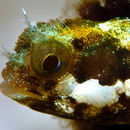en
names in breadcrumbs


The genus Acanthemblemaria includes a number of species and species complexes in the tropical western Atlantic (and eastern Pacific), all of whom live in tube-like holes on hard rock or coral bottoms. They are characterized by blunt heads with spines and branched cirri over the eyes, none of which are apparent on larvae. Their colors and markings are notoriously variable within species, especially between males and females, and many species share the basic bars and spot patterns on the head. Larvae of Acanthemblemaria have pointed snouts until transition and morphologically resemble other blennioid larvae. Fin-ray counts are useful for identification; most species have more dorsal-fin soft rays and anal-fin rays than the labrisomid blennies and the Emblemariopsis group. The Emblemaria overlap to some degree, but have 23 or fewer anal-fin soft rays vs. typically 23 or more in Acanthemblemaria. Procurrent caudal-fin rays can be helpful: Acanthemblemaria usually have 4 or 5, two or more fewer than potentially-overlapping Labrisomus and Malacoctenus and one or two more than most Emblemariopsis and some Emblemaria (but the same as the E. pandionis group). There is some degree of overlap in fin-ray counts among Caribbean Acanthemblemaria species; most species share counts with two or three congeners, but often the congeners do not have overlapping geographic ranges and the process of elimination can be diagnostic. Unfortunately, some species complexes are made up of cryptic species with differing fin-ray counts in various regions, making it necessary to know the precise locality and the potentially sympatric congeners to be sure of a species-level identification (in the absence of a DNA confirmation). The review by Smith-Vaniz and Palacio (1974) presents the ranges and fin-ray counts for many species. Notably, the number of species of Acanthemblemaria at one location varies from one to five; the maximum number coexisting at one location is found in Panama (5; 6 or maybe 7 along the overall coastline), Belize (5), Cuba and the Bahamas (5), and Venezuela (4 overall coastline). Florida has only 2 or 3, PR and the USVI have 3.
Diagnosis: The strong modal fin-ray count of D-XX-XXI,15 sA-23 P-13 with 35 or 36 total dorsal-fin elements indicates Acanthemblemaria sp. (Panama), A. aspera (from Colombia; other populations have modal 16 dorsal-fin soft rays), and the Emblemaria pandionis complex, as well as broadly overlapping the range of A. spinosa (not found in Panama) and several other Acanthemblemaria and Emblemaria species. The presence of cryptic species with differing fin-ray counts in various regions requires that the precise locality and the fin-ray counts of sympatric chaenopsids (or DNA sequencing) be known for species-level identification among this large group of species. (DNA) Description: n7527a 92
Acanthemblemaria is a genus of chaenopsid blennies native to the Atlantic and Pacific Oceans.
Acanthemblemaria: Greek, akantha = thorn + Greek, emblema, -atos, anything that is nailed, knocked in; also anything with bass or high relief[1]
Body elongated; head short and blunt; pointed or blunt spines on snout, below eye, sometimes on top of head; 2 rows of very well developed teeth on the roof of the mouth; 1 pair of branched or unbranched cirri over eyes; cirri over nostrils; usually with a notch between the spiny and soft parts of the dorsal fin
The 21 recognized species in this genus are:[2]
Acanthemblemaria are mostly filter feeding fishes, they inhabit coral reefs, rocky reefs and abandoned worm and mollusc tubes.[4]
They feed mostly on passing benthic crustaceans, zooplankton, benthic worms,
Acanthemblemaria is a genus of chaenopsid blennies native to the Atlantic and Pacific Oceans.